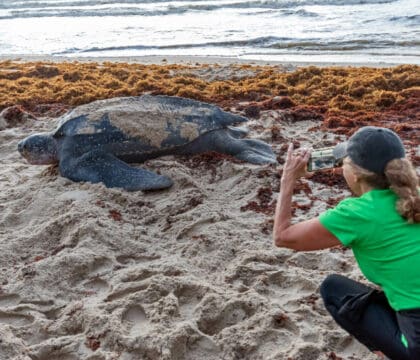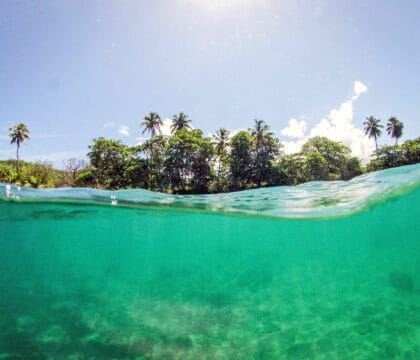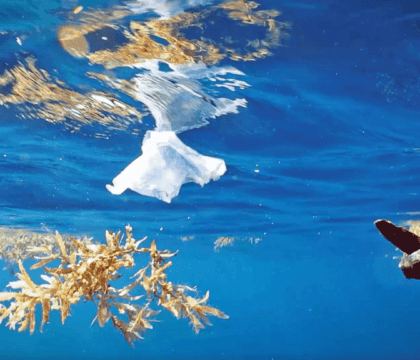November 7, 2017 • Trip Reports
View from Utula’aina Lookout, Vava’u, Tonga. © Doug Perrine
After two days, 6,000 miles, two flight schedule changes, and two aborted landings, I have arrived in the idyllic island cluster of Vava’u in the Kingdom of Tonga. I ask myself why I have come all this distance to see humpback whales when my own home, Hawaii, is host to larger numbers of these marine mammals every year. The proposition is that Tongan whales are very different from Hawaiian whales, in their behavior, as well as their appearance and their genetic code, which indicates that southern hemisphere whales have been breeding separately from those in the northern hemisphere for many thousands of years, and that there is little interbreeding between the Tonga whales and others in the southern hemisphere. Whether from genetic predisposition or habituation from a quarter century of having humans jump in the water to swim with them, Tongan whales are felt to be generally more accepting of awkward bipedal primates amongst them than are their North Pacific counterparts. There is also an important legal distinction. Visitors may swim with whales under Tongan law if they are on a licensed whale-swim vessel and under the supervision of a licensed whale guide. In the USA swimming with whales is not allowed except in the conduct of scientific research under strictly controlled permits.
The 33-foot catamaran we use on our outings to watch and swim with whales. © Doug Perrine
Working from a comfortable 33-foot motor catamaran with an enclosed cabin, we are not deterred by the rain clouds that darken our first morning. In true tropical fashion, they abate quickly, and rays of sunshine are soon dancing about us. The passengers are split into two groups of four, as this is the maximum number allowed in the water with the guide at a time. When the first group gets in I am concerned that some of them are so excited they might swallow enough water through their snorkels to drown themselves! But soon all have made it over to the spot where our guide is floating patiently above a mother humpback and her calf. Those of us waiting on the boat are treated to an aerial display by a Brown Booby, which swoops repeatedly toward the boat, stalling in front of us as if posing for pictures. Tiring of that game, it soars over to the swimmers, decides they must have found something interesting, and plops into the water next to them, submerging its head to try to see what everyone is looking at. When the calf finally surfaces to breathe it circles around and swims directly at the watchers, coming so close that some of the team are back-pedaling! The mother surfaces, swims a short distance away, then circles back to the group with her calf. The routine is repeated with the second group, and then once more with each group before we move on.
Members of our group snorkel near a humpback mother calf pair. © Doug Perrine
In the evening we are serenaded by a Tongan band, some using homemade instruments, such as a bass constructed from a wooden crate. On one number they are accompanied by one of the kitchen staff performing a Tongan dance. The following evening we have a presentation by a researcher who has been using drones launched from our vessel to study whale behavior. His aerial footage is stunning.
In the evening we are serenaded by a Tongan band at our resort. © Doug Perrine
On our third day we witness the improbable act of breaching, whereby a 40-ton mammal with just a couple of strokes of its tail launches its entire mass out of the water. We also locate a singer, drop the hydrophone, and are treated to full-on performance of “whale opera.” Male humpbacks produce the longest and most elaborate songs of any marine mammal. Their production is believed to be somehow related to courtship and reproduction, but three decades of research have not elicited how this works. We have learned that the songs usually attract other males. Later in the trip all members of our group are able to get in the water with a singer and experience the unforgettable and haunting sensation of having their bodies vibrate like sounding boards from eerie noises emanating from the depths.
We enjoy many intimate, in-water encounters with Tongan humpbacks. © Doug Perrine
Sunday is an obligatory day of rest in Tonga. Some of our group take a picnic and snorkel trip to one of the postcard-perfect private islands nearby. The islands of Vava’u are reminiscent of the Rock Islands of Palau, as well as parts of the Raja Ampat group in Indonesia. There are dozens of small islands that are heavily forested and surrounded by white sand beaches without a soul to be seen. The sea around them is painted in swirls of turquoise and azure according to the depth of the water and whether the substrate is coral or sand.
The idyllic beach at Talihau, Vava’u, Tonga. © Doug Perrine
Others of us take in a church service at a Tongan village close to our resort. Church choirs are the focus of community life in Tonga. Frequent practice and intense competition produce some of the finest choral performances to be heard in the world. The experience is vaguely reminiscent of the enthusiasm of some evangelistic worship sessions in the deep south, but is really in a league all its own, and has to be seen and heard to be believed.
Sunday is a day of rest in Tonga, and church choirs are a focus of community life. © Doug Perrine
Another way to pass the time on Sundays, or in the afternoon after boating is finished, is snorkeling in the shallows in front of the resort. There is no coral reef here, but a few scattered coral heads in a shallow bed of seagrass. Scattered about are sea anemones, larger than some of the coral heads, which shelter an anemonefish and a school of domino damselfish. Colorful tropicals, such as butterflyfish and angelfish, flit through the seagrass and aggregate under the dock, along with dense schools of baitfish, and a few larger predators, including jacks, barracuda, and trumpetfish, waiting to pick off any smaller fish that make a mistake.
Humpback whales in a competitive group, or heat run, swim over coral reef. © Doug Perrine
On Monday we see our first competitive group, usually referred to locally as a “heat run.” This is a social group consisting of a female, sometimes with a calf, and any number of males in hot pursuit. The male closest to the female is called the escort, and the other males are challengers. The males, particularly the escort, exhibit a range of aggressive and competitive behaviors and postures, including breaches, fin slaps and chin slaps, jaw claps, and bubble trails. Later we find a resting mother and calf that seem oblivious to the presence of our swimmers, all of whom get several turns with them.
Fruit bats hanging in the trees. © Doug Perrine
We go over to Coral Gardens for lunch and a snorkel, and are treated to a view of fruit bats hanging from the casuarina trees. These fascinating flying mammals are important pollinators, and therefore critical to the survival of various plant species, but have been sadly eliminated from many Pacific islands due to their popularity when served in soup.
A humpback calf and its mother eye us curiously. © Doug Perrine
The next day we are treated to swims with another mother whale and her calf. The calf, like most youngsters everywhere, is curious, and swims a broad arc to inspect all the swimmers each time it surfaces for air. The mother, once again, seems indifferent to the humans in close proximity to her offspring. By now, I’m convinced that there is a real difference in behavior between Tongan and Hawaiian whales. While we do experience “friendly” whales in Hawaii, the majority of mothers herd their calves away from boats or humans in close proximity. Often, however, it is not the female, but her male escort who is the most protective. This highlights another difference between the two breeding populations that makes Tonga an ideal place for encounters between humans and whales: in Hawaii, most females with calves have a male escort; in Tonga most cow / calf pairs do not have an escort. Nobody knows why this is so, but it certainly contributes to the safety of swimming with whales to not have a forty ton overprotective male trying to interfere.
A school of silvery baitfish inside Swallows Cave. © Doug Perrine
On the way in we stop for a swim at Swallows Cave, where a school of silvery baitfish shelter in a seaside cavern, illuminated by dancing shafts of sunlight penetrating the entrance. Colorful reef fish swim along the walls of the cavern, where there are small corals and sponges growing.
We experienced many encounters with humpback moms and calves during our expeditions. © Doug Perrine
The remaining days include another singer, more moms and calves, and competitive groups, but Thursday is special. On this day instead of going on the boat we take taxis to a jewel of a beach at the far end of the island where our resort is located. Karen Stone, the founder of the Vava’u Environmental Protection Association (VEPA), meets us there and gives us an introduction to their efforts to protect the local environment, in collaboration with local communities, such as the village where we are now standing. This village has established one of the first marine protected areas in Tonga, where fishing is regulated to protect resources for the future.
We joined VEPA in cleaning up a beach, recording each trash item found. © Doug Perrine
After our orientation we join a team of VEPA volunteers to pick up trash off the beach, recording the types and amounts for VEPA’s database. We are stunned at how much refuse can be collected in a short time from a small section of beach that looks pretty clean at first glance. Once our eyes are trained we start finding every manner of plastic, cloth, rubber, and metal product produced by man half buried in the sand. It’s actually quite enjoyable doing this light labor while taking in the stunning scenery and everyone feels good about participating with locals working to reclaim their natural environment. For me the best part comes later when I’m looking through my photos of the event. In one series I see some other beachgoers in the background staring at our group in the first few photos, then starting to pick up trash themselves in the following frames. The best part about volunteerism is that it is often contagious.
Click here to learn more about our Tonga: Snorkeling with Humpback Whales expedition, including itineraries, dates, pricing, and photos, and sign-up to join Doug on our Tonga expedition in 2018!




